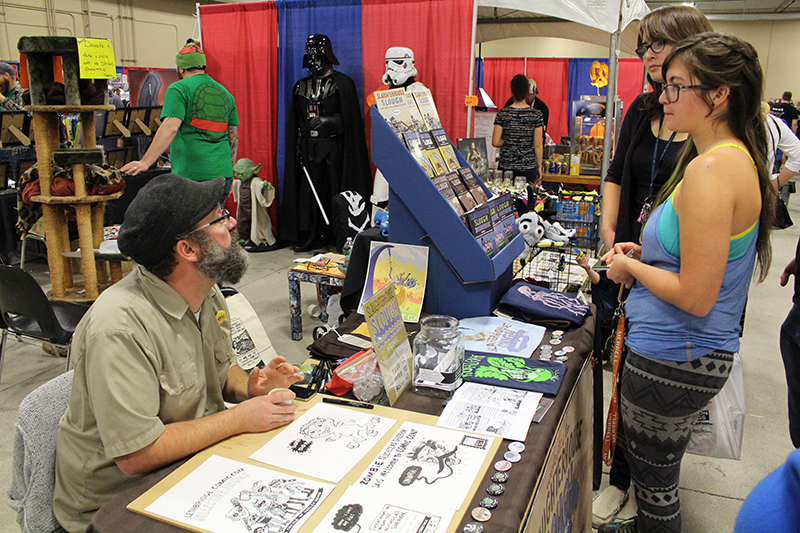Eric Dyck, creator of Slaughterhouse Slough introduces himself to a few interested fans at Comic Con on Oct. 17.

When the Fulton Bill was enacted in 1949, it made it an offence to distribute magazines with content deemed violent or criminal, which in turn put a veil of censorship over Canadian comic books.
Unable to debate against the intangible aspects of the Fulton Bill, comic book artists were forced to take their content underground for 25 years.
But in 1973 with tales of the future, full-colour pages and the first superhero seen on newsstands since the 40s Captain Canuck led the way for a comic revolution, according to Library and Archives Canada.
Captain Canuck creator, Richard Comely, did the penciling, inking, colouring and lettering the old fashioned way by hand. Despite the original charm of comics being lost, Comely recognizes there is a higher level of admiration for the graphics.
“Comic creation has evolved to a certain degree and is considered more of an art form than it originally was. There’s greater appreciation for the illustrations and story telling than in the past,” Comely said.
When award-winning comic writer and artist, Nat Jones, moved from the United States to Edmonton a number of years ago he noticed Canadians were more passionate about the art work than Americans were.
While he says it’s great a previously outcast art form is now predominate in our culture, Jones says the biggest issue is getting people to buy the books.
“We got so many people wearing the t-shirts, they’re seeing the films and they’re going to conventions, but solid readership could be increased because there’s so many great writers and artists who deserve exposure.”
Local comic book artist, Eric Dyck, won’t deny the importance of getting people purchasing comics but says independents can offer the reader an entirely different experience.
“What’s exciting about original comic creators is quite often there’s something going on which resonates and the reader can relate on a more intense or personal level,” Dyck said. “It is operating on a whole other level when you see yourself in someone else’s story whether its novels, journalism or comics.”
Dyck uses print and Internet mediums to publish his creation Slaughterhouse Slough, a cartoon chronicling life in Lethbridge and as he watches the independent market grow online, he’s seeing artist exposure of all varieties.
“With online comics, everything becomes more tribal as everyone narrows in on their specific interests. Within the broader comic community women creators, LGBTQ and cartoonists of colour are becoming way more accessible because of the opening of culture. I see people within those different communities in Lethbridge getting way more traction,” Dyck said.
Even though he knows there’s no stopping the development of the virtual world, Comely believes it’s the collectability of printed comic books will stop the medium from going extinct.
“People still want the printed copy, it’s a physical object you can collect, treasure and don’t need batteries to enjoy. With digital content there’s a threshold, people start to re-examine the original. Though digital will continue to grow, obviously, the printed comic book, printed book or printed magazine will never disappear.”



